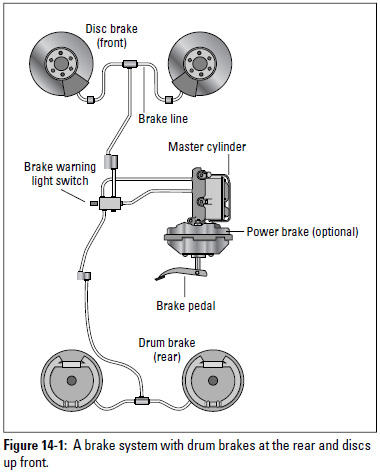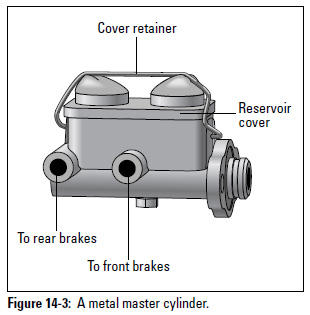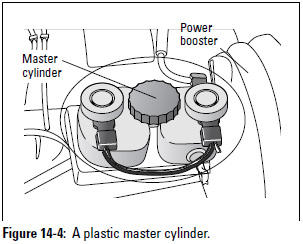One reason that today's vehicles are the safest in history is that, since 1968, all vehicles come equipped with dual brake systems to ensure that if one set of brakes fails, the other set can still stop your car. Your vehicle also has a dashboard light to warn you if your brakes are malfunctioning. A growing number of modern vehicles not only are equipped with hydraulic brake systems but also feature electronic brake systems that operate even more safely and efficiently.
Figure 14-1 shows a basic brake system with a brake booster, disc brakes on the front wheels, and drum brakes on the rear wheels. Your vehicle may havedisc brakes all around, but the principle is the same in any case.
 |
The following sections take a look at each of the components of a basic hydraulic brake system, starting with the first point of contact between you and your brakes and working down the line to the brakes themselves.
The Brake Pedal
The brake pedal in your vehicle is attached to a shaft that leads to the brake master cylinder. When you step on the brake pedal, small pistons in the master cylinder force brake fluid out of the master cylinder and into the brake lines.
Tip: If your brakes are working properly, the pedal should stop a couple of inches from the floor. It should push down easily, stop firmly at its lowest point without feeling spongy, and stay put instead of sinking down slowly when you put normal pressure on it. Chapter 15 shows you how to check the brakes on your vehicle.
Power Brakes
Today, most vehicles have power brakes with a brake booster located between the brake pedal and the master cylinder to increase the force applied to the pistons in the master cylinder so that your car can stop with less effort on your part (see Figure 14-2). The two most common types of power brake boosters are vacuum-assisted boosters, which use engine vacuum and atmospheric pressure to do the job; and hydraulic-assisted boosters (commonly referred to as hydro-boost units), which use hydraulic pressure from the car's power steering to accomplish the same thing. Some vehicles with anti-lock braking systems (ABS) have a hydraulic pump to generate pressure for booster operation.
 |
Your owner's manual can tell you what kind(s) of brakes you have on your vehicle, in case you don't already know, but seeing for yourself is more fun.
The Brake Master Cylinder
Under the hood of your car, usually up near the firewall on the driver's side, you should see either a metal box (see Figure 14-3) or, on most newer vehicles, a plastic container (see Figure 14-4). This is the brake master cylinder (refer to Figure 14-2). It's filled with brake fluid and is connected to your brake pedal, with brake lines leading from it to the four wheels of your vehicle. Stepping on the brake pedal activates the brake power booster, which activates the pistons in the master cylinder, forcing brake fluid out of the master cylinder into the brake lines. When you release the pedal, the fluid flows back into the master cylinder.
 |
Dual BrakesA dual brake system simply means that the inside of the master cylinder is divided into two compartments, each filled with brake fluid. On a vehicle with rear-wheel drive, one compartment has brake lines that lead to the brakes on the front wheels; the other compartment has lines leading to the brakes at the rear wheels (refer to Figure 14-3). If a leak or a block develops in one set of lines, the fluid in that compartment is lost or useless. But the other compartment and set of brakes can still stop your vehicle. It may not stop smoothly, but it will stop, and in such a case, that's all that counts! This simple modification has saved countless lives. Most front-wheel drive vehicles have a diagonally split hydraulic brake system that ties the right-front wheel with the left-rear wheel and the left-front wheel with the right-rear wheel. That's because the front brakes on front-wheel drive vehicles do almost 90 percent of the braking. By diagonally splitting the hydraulic system, you always have one front brake and one rear brake operating in the event of a hydraulic failure. |
Brake Lines
The brake lines run from the master cylinder along the frame of your vehicle to each wheel. The lines are made of steel except for the portions that lie right near your front wheels and your rear axle. These portions are made of rubber or synthetic material that's flexible enough to contend with the greater amount of movement that takes place in these areas as thesuspension system works and the wheels turn when you steer.
 |
Brake Fluid
Although electronic brakes using electric motors to do the work are in development, brake systems today still are activated by hydraulic fluid called, you guessed it, brake fluid. You can make your brake system work better and live longer if you change the fluid — or have it changed by your mechanic — once every 24 months, regardless of mileage. Brake fluid soaks up moisture from the atmosphere. As this water contaminates it, the boiling point of the brake fluid lowers until it can reach a point where it begins to boil as brake heat builds up. When that happens, the air bubbles in the boiling fluid cause the brakes to fail, a situation nobody wants.
The parts discussed thus far are common to most hydraulic brake systems. Now for some of the major differences: When you press the brake pedal and force the brake fluid from the master cylinder into the brake lines, what happens next depends on the type of brakes you have. For many years, cars had drum brakes (see Figure 14-5) on all four wheels. As you can see in Figure 14-1, some vehicles have drum brakes on the rear wheels and disc brakes (see Figure 14-8) on the front wheels. Today, many vehicles have four-wheel disc brakes, and most have the power brakes described earlier in this chapter. Anti-lock braking systems (ABS) also have become popular, and I get to them shortly.
From Auto Repair for Dummies, copyright © 2009 by Wiley Publishing, Inc., Indianapolis, Indiana. Used by arrangement with John Wiley & Sons, Inc.






